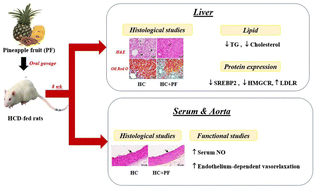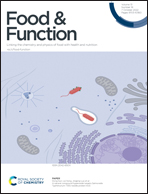Pineapple fruit improves vascular endothelial dysfunction, hepatic steatosis, and cholesterol metabolism in rats fed a high-cholesterol diet
Abstract
Hypercholesterolaemia is a significant risk factor for developing vascular disease and fatty liver. Pineapple (Ananas comosus), a tropical fruit widely cultivated in Asia, is reported to exhibit antioxidant and cholesterol-lowering activity; however, the potential hypolipidaemic mechanisms of pineapple fruit remain unknown. Therefore, we aimed to identify the anti-hypercholesterolaemic mechanism of pineapple fruit and to study the effect of pineapple fruit intake on hypercholesterolaemia-induced vascular dysfunction and liver steatosis in a high-cholesterol diet (HCD)-fed rats. Male Sprague Dawley rats were fed with standard diet or HCD, and the pineapple fruit was orally administered to HCD-fed rats for 8 weeks. At the end of treatment, vascular reactivity and morphology of aortas, as well as serum nitrate/nitrite (NOx), were determined. Liver tissues were also examined for histology, lipid content, 3-hydroxy-3-methylglutaryl-coenzyme A reductase (HMGCR) activity, and protein expression of cholesterol metabolism-related enzymes. Results showed that pineapple fruit reduced the levels of hepatic cholesterol and triglycerides, and improved histological characteristics of a fatty liver in HCD-fed rats. Pineapple fruit also increased serum NOx, restored endothelium-dependent vasorelaxation, and reduced structural alterations in aortas of rats fed the HCD. In addition, a reduction of HMGCR activity and the downregulation of hepatic expression of HMGCR and sterol-regulatory element-binding protein 2 (SREBP2), as well as the upregulation of hepatic expression of cholesterol 7α-hydroxylase (CYP7A1) and LDL receptor (LDLR) were found in pineapple fruit-treated hypercholesterolaemic rats. These results indicate that pineapple fruit consumption can restore fatty liver and protect vascular endothelium in diet-induced hypercholesterolaemia through an improvement of hepatic cholesterol metabolism.



 Please wait while we load your content...
Please wait while we load your content...